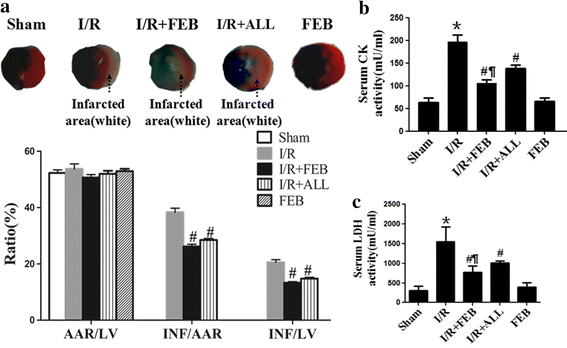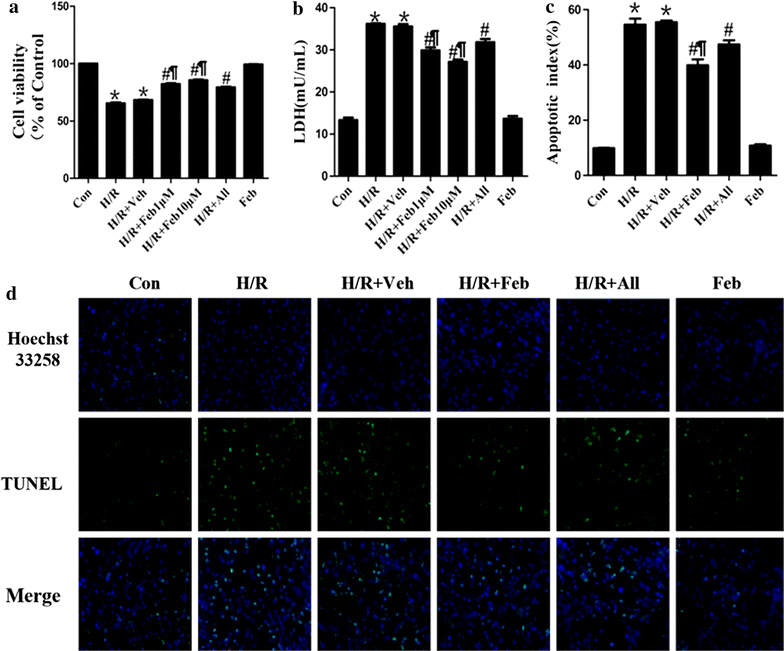Febuxostat pretreatment attenuates myocardial ischemia/reperfusion injury via mitochondrial apoptosis
- PMID: 26136232
- PMCID: PMC4489215
- DOI: 10.1186/s12967-015-0578-x
Febuxostat pretreatment attenuates myocardial ischemia/reperfusion injury via mitochondrial apoptosis
Abstract
Background: Febuxostat is a selective inhibitor of xanthine oxidase (XO). XO is a critical source of reactive oxygen species (ROS) during myocardial ischemia/reperfusion (I/R) injury. Inhibition of XO is therapeutically effective in I/R injury. Evidence suggests that febuxostat exerts antioxidant effects by directly scavenging ROS. The present study was performed to investigate the effects of febuxostat on myocardial I/R injury and its underlying mechanisms.
Methods: We utilized an in vivo mouse model of myocardial I/R injury and an in vitro neonatal rat cardiomyocyte (NRC) model of hypoxia/reoxygenation (H/R) injury. Mice were randomized into five groups: Sham, I/R (I/R + Vehicle), I/R + FEB (I/R + febuxostat), AL + I/R (I/R + allopurinol) and FEB (febuxostat), respectively. The I/R + FEB mice were pretreated with febuxostat (5 mg/kg; i.p.) 24 and 1 h prior to I/R. NRCs received febuxostat (1 and 10 µM) at 24 and 1 h before exposure to hypoxia for 3 h followed by reoxygenation for 3 h. Cardiac function, myocardial infarct size, serum levels of creatine kinase (CK) and lactate dehydrogenase (LDH), and myocardial apoptotic index (AI) were measured in order to ascertain the effects of febuxostat on myocardial I/R injury. Hypoxia/reperfusion (H/R) injury in NRCs was examined using MTT, LDH leakage assay and terminal deoxynucleotidyl transferase dUTP nick end labeling (TUNEL) assay. The underlying mechanisms were determined by measuring ROS production, mitochondrial membrane potential (ΔΨm), and expression of cytochrome c, cleaved caspases as well as Bcl-2 protein levels.
Results: Myocardial I/R led to an elevation in the myocardial infarct size, serum levels of CK and LDH, cell death and AI. Furthermore, I/R reduced cardiac function. These changes were significantly attenuated by pretreatment with febuxostat and allopurinol, especially by febuxostat. Febuxostat also protected the mitochondrial structure following myocardial I/R, inhibited H/R-induced ROS generation, stabilized the ΔΨm, alleviated cytosolic translocation of mitochondrial cytochrome C, inhibited activation of caspase-3 and -9, upregulated antiapoptotic proteins and downregulated proapoptotic proteins.
Conclusions: This study revealed that febuxostat pretreatment mediates the cardioprotective effects against I/R and H/R injury by inhibiting mitochondrial-dependent apoptosis.
Figures







Similar articles
-
Ginsenoside Rd attenuates myocardial ischemia/reperfusion injury via Akt/GSK-3β signaling and inhibition of the mitochondria-dependent apoptotic pathway.PLoS One. 2013 Aug 16;8(8):e70956. doi: 10.1371/journal.pone.0070956. eCollection 2013. PLoS One. 2013. PMID: 23976968 Free PMC article.
-
Panax quinquefolium saponin attenuates cardiomyocyte apoptosis and opening of the mitochondrial permeability transition pore in a rat model of ischemia/reperfusion.Cell Physiol Biochem. 2014;34(4):1413-26. doi: 10.1159/000366347. Epub 2014 Oct 3. Cell Physiol Biochem. 2014. PMID: 25301366
-
Kaempferol protects cardiomyocytes against anoxia/reoxygenation injury via mitochondrial pathway mediated by SIRT1.Eur J Pharmacol. 2015 Aug 15;761:245-53. doi: 10.1016/j.ejphar.2015.05.056. Epub 2015 Jun 15. Eur J Pharmacol. 2015. PMID: 26086862
-
Mitochondrial bioenergetics and cardiolipin alterations in myocardial ischemia-reperfusion injury: implications for pharmacological cardioprotection.Am J Physiol Heart Circ Physiol. 2018 Nov 1;315(5):H1341-H1352. doi: 10.1152/ajpheart.00028.2018. Epub 2018 Aug 10. Am J Physiol Heart Circ Physiol. 2018. PMID: 30095969 Review.
-
Melatonin in cardiac ischemia/reperfusion-induced mitochondrial adaptive changes.Cardiovasc Hematol Disord Drug Targets. 2007 Sep;7(3):163-9. doi: 10.2174/187152907781745297. Cardiovasc Hematol Disord Drug Targets. 2007. PMID: 17896956 Review.
Cited by
-
Tissue accumulation of neutrophil extracellular traps mediates muscle hyperalgesia in a mouse model.Sci Rep. 2022 Mar 9;12(1):4136. doi: 10.1038/s41598-022-07916-8. Sci Rep. 2022. PMID: 35264677 Free PMC article.
-
Mitochondrial quality control mechanisms as molecular targets in cardiac ischemia-reperfusion injury.Acta Pharm Sin B. 2020 Oct;10(10):1866-1879. doi: 10.1016/j.apsb.2020.03.004. Epub 2020 Apr 8. Acta Pharm Sin B. 2020. PMID: 33163341 Free PMC article. Review.
-
Inhibition of Caveolae Contributes to Propofol Preconditioning-Suppressed Microvesicles Release and Cell Injury by Hypoxia-Reoxygenation.Oxid Med Cell Longev. 2017;2017:3542149. doi: 10.1155/2017/3542149. Epub 2017 Sep 19. Oxid Med Cell Longev. 2017. PMID: 29181124 Free PMC article.
-
Exercise, Nrf2 and Antioxidant Signaling in Cardiac Aging.Front Physiol. 2016 Jun 17;7:241. doi: 10.3389/fphys.2016.00241. eCollection 2016. Front Physiol. 2016. PMID: 27378947 Free PMC article. Review.
-
Effects of febuxostat on atrial remodeling in a rabbit model of atrial fibrillation induced by rapid atrial pacing.J Geriatr Cardiol. 2019 Jul;16(7):540-551. doi: 10.11909/j.issn.1671-5411.2019.07.003. J Geriatr Cardiol. 2019. PMID: 31447893 Free PMC article.
References
Publication types
MeSH terms
Substances
LinkOut - more resources
Full Text Sources
Other Literature Sources
Research Materials

